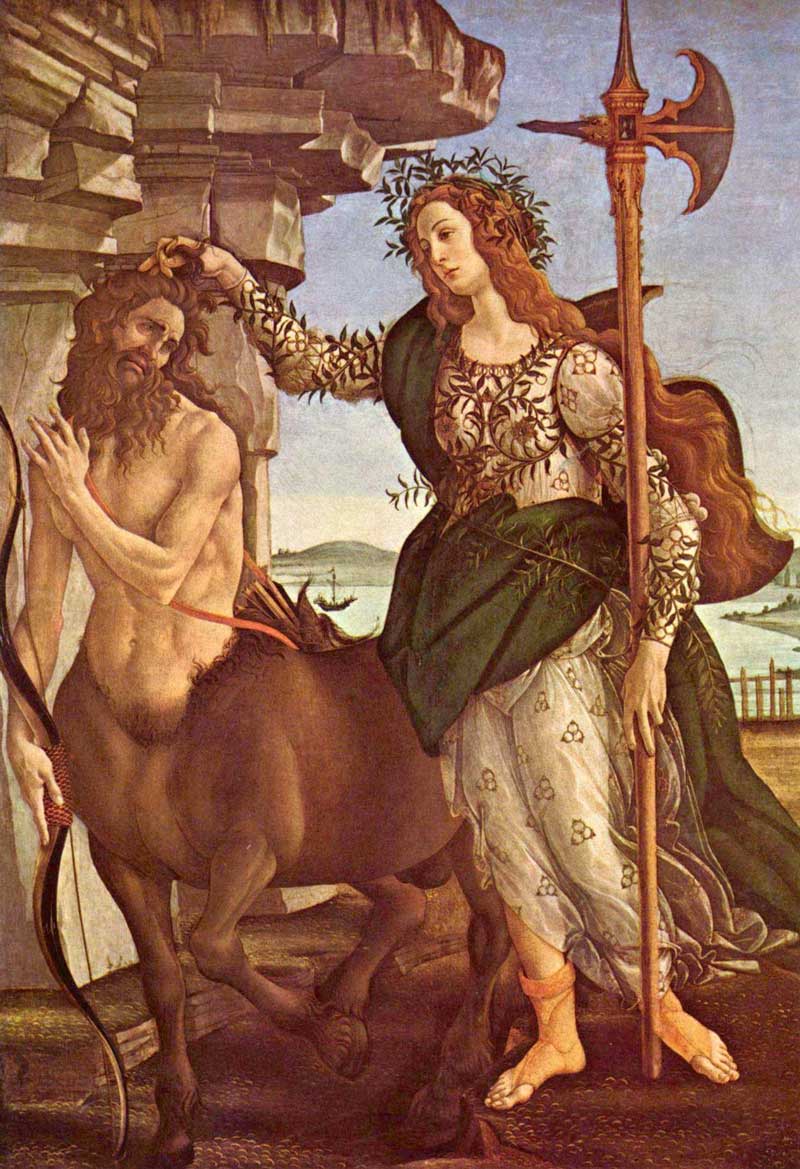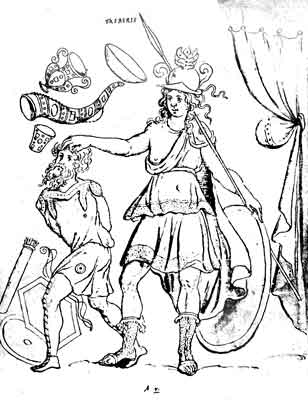.

CITY OF FLORENCE AND THE CENTAUR, (Formerly called "Pallas and the Centaur.")
, Sandro Botticelli, c. 1482
Ever since the discovery of one of Botticelli's principal masterpieces in a dark corner of a room in the Pitti palace, it has been the subject of special articles and has been called, by common consent, " Pallas and the Centaur." Before giving my reasons for believing that Botticelli, when he painted his picture, had quite a different idea in his mind, I shall review the apparently unimpeachable evidence for the commonly accepted title.
The latest word on the subject is that of Horn, in his published (1908) sumptuous folio, Botticelli, anxiously expected for many years. In his opinion "Pallas and the Centaur " is not the lost Pallas done by Botticelli for Lorenzo de' Medici, but a work painted in about 1488, as it is a trifle later in manner than the " tondo " of 1487. It appears in the inventory of Medici property, dated 1516, as : ja figura conuna Minerva ejo Centauro, which is practically identical with the description in the first draught of this inventory : ja Figura conuna Minerva e centauro in tela e asse dritto. In the division of the Medici property it fell to the share of Giovanni delle Bande Nere, and in the inventory of the property at his Villa of Castello, made in 1598, it is catalogued merely as : una donna e un centauro. What later documents call it hardly matters. It is the title in the earliest inventory that seemed to settle the matter conclusively.
In two words, the scene shows a woman, evidently of allegorical character, holding a halberd in her left hand, her clinging robe bespangled with the three interlaced rings that were the emblems of the Medici, while about her arms, her body above the waist, and her hair are wound garlands of olive branches. To her back is fastened by straps what has been interpreted as a quiver, but which evidently is a shield. By her right side stands a resigned-looking, bearded centaur whom she holds by the hair as a sign of his subjection, while he still clings to his loosened bow, and the arrows rest in a quiver at his back. In the background is a seaport with a ship, and the scene is laid in the fields, above which towers a great rock.
The general interpretation that Pallas (or Minerva) is here the representative and patroness of the Medici, who are triumphing over chaos in the guise of the centaur, is of course obvious if one accepts the inventory's identification of the female figure as Pallas. More specific suggestions have been made ; such as that it commemorated the triumph of the Medici over the Pazzi, the victorious policy of Lorenzo, and in particular his alliance with Pope Innocent VIII (1487-92), when Machiavelli says that the Florentines lived in great felicity. Horn says (p. 160):
" Although no allusion occurs in Greek or Roman art or literature . . . which might explain or account for this conception of Pallas with a centaur, Botticelli, notwithstanding, appears to have taken the motive of the goddess plucking the centaur by the hair of the head from the antique. On the frieze of the loggia which forms the background of Botticelli's panel of the Calumny of Apelles . . . the painter has represented a woman dragging along by the hair of the head a centaur, who is bound and ridden by a Cupid, a composition which must have been taken directly from some work of ancient art."

FIGURE 2. CITY OF TREBERIS AND THE BARBARIAN, IN THE ROHAN CALENDAR OF 354 A.D. (Strzygowski, pl. vii).
I believe I have found the ancient prototype which Horn rightly surmised that Botticelli copied, and that from this prototype Botticelli borrowed not only the main elements of his composition, but its fundamental idea as well. This original is one of the illustrations of the famous late Roman Calendar, called the Calendar of the year 354, drawn up or revised by Furius Dionysius Philocalus, the secretary of Pope Damasus. This artistic production was familiar to the men of the Renaissance throughout Europe. Copies of the original had been made by scribes of the Carlovingian age (ninth century), and these in turn were copied during the Renaissance. Facsimiles of part of the most notable set of copies, that of Peirese, have been reproduced in a special volume by Strzygowski, 1 and I hope soon to publish other drawings of the series which I have discovered, which Strzygowski and others have considered lost. The originals from which these were taken have disappeared. The most pretentious of these drawings, which include the labors of the months, the planets, etc., are placed at the beginning and represent the four principal capital cities of the Roman Empire in the middle of the fourth century : Rome, Constantinople, Alexandria, Trier (Treves). Each city is personified by a woman who occupies the centre of each picture. It is in the last of these pictures, Treberis or Trier (PL VII), the principal city of the West, 2 that we see the composition which furnished Botticelli with his theme and its arrangement. 3
The female figure of Treberis, garbed as an Amazon, and armed, as such a frontier city should be, with lance, shield, and helmet, has seized with her right hand a long-haired and bearded barbarian. He crouches submissively by her side, his hands bound behind him, his bow and arrows cast aside. In place of these emblems of war, he is having showered upon him the accompaniments of peace vases and cups of gold and a horn of plenty. The evident symbolism is that Roman good government, typified by Trier, has given to the barbarous German tribes wealth and peace in place of their previous lawless and poverty-stricken condition.
The differences between the two compositions, such as the substitution of the centaur for the wild tribesman, of the woman's peaceful garb for that of the Amazon, are only what was to be expected of an artist of Botticelli's originality, who would use such models only in a suggestive way. In fact, the peaceful garments of " Florentia " were as obviously indicated for her as the warlike ones had been for " Treberis," an essentially military centre.
The resemblances are obvious. The general lines of the composition are the same, and this identity rules not only in the general attitude, moral relationship, and relative position of the two figures, but in such details as the action of the woman's right arm in seizing the centaur's hair. The centaur represents the natural forces and possibilities, as well as the uncultured and chaotic condition of the Florentine territory. In place of the crude symbols of wealth in the model, Botticelli has depicted it more subtly as rising from the fields and brought into harbor in ships. Sea, mountain, and broad country the three main natural elements of the state are picturesquely combined. But the essential point is that in the female figure we must recognize, not Pallas-Minerva, but " Florentia," the city herself, like ' Treberis," in the ancient model. Florence, wreathed in the olive of peace and under the guidance of the Medici, with shield put aside and halberd held merely as the emblem of authority, is leading the people of her territory in the paths of peace and wealth. Wishing to express this idea in art, some humanist who had seen this Calendar evidently thought the Trier composition could serve Botticelli as suggestive model.
Even if we did not have the analogy of the 'Trier in the Calendar, the interpretation of the figure as Florence would have a prima facie preference over that of Pallas-Minerva. The use of such personifications of cities was familiar to Greek art even before Eutychides, in the fourth century B.C., had carved his masterpiece of the Tyche of Antioch. It continued as a commonplace in Greco-Roman and even in Byzantine art. 4 So we are hardly surprised to find that it had entered into the fibre of the artistic thought of Italy as early as the fourteenth century. Before the close of the fifteenth century it had become the favorite exercise of humanists and artists alike to find in Greek and Latin sources themes for artistic treatment. In an able article Professor F. Wickhoff 5 has recently sought to show how Botticelli himself was one of these interpreters of the antique. In his famous "Spring" he sees a nuptial theme whose motive was derived from the Mythologicon of Fulgentius, while the special idea of representing the bridegroom as Mercury was drawn from Martianus Cappella's Marriage of Mercury and Philology. The latter work also inspired, he believes, the painter's wedding-scene of the Villa Tornabnoni. Finally, he sees in the Codex Salmasianus, a manuscript known in Florence in Botticelli's time, the source of his "Birth of Venus." Other classic sources of Botticelli's are so well known as to require no comment.
We can hardly picture Botticelli himself as a master of ancient literature. But, as among the noted coterie of the court of the Medici devoted to antique literature, the bond between litterateurs and artists was perhaps closer than it was at any other art centre at any time during the Renaissance, we may well believe that Botticelli was " coached " in composing all these themes, including this "Florentia," which is, for so many, the most sympathetic of his works. All who love Florence, and they are probably more numerous than the lovers of any other city, may feel glad that they can think of her in the guise of so exquisite an embodiment.
1 Die Calenderbilder des Chronographen vom Jahre 354, issued as the first Eryiinzungsheft of the Jahrbuch d. k. d. Archaolog. Instituts, Berlin, 1888.
2 Under Constantine Treberis reached, perhaps, its greatest importance. It was the great Roman bulwark and centre of culture in relation to Germany. The Constantinian coinage has this very scene of the seizing of the German tribesman by the hair.
3 It is naturally impossible to prove that either Botticelli or the Florentine humanists actually saw these illustrations of the Roman Calendar. But it was the opinion of De Rossi and Strzygowski that the Vienna copy of the Calendar was made in Botticelli's youth, proving that it was known in the early Renaissance. Peiresc's copy was made in 1620-21.
4 Note the famous mosaic portrait of King Theodoric with the cities of Rome and Ravenna on either side.
5 Jahrbuch d. Preuss. Kunstsam. XXVII, pp. 198-207.
A. L. FROTHINGHAM.
----
Fine Art Prints | Greeting Cards | Phone Cases | Lifestyle | Face Masks | Men's , Women' Apparel | Home Decor | jigsaw puzzles | Notebooks | Tapestries | ...
----
| Ancient Greece
Science, Technology , Medicine , Warfare, , Biographies , Life , Cities/Places/Maps , Arts , Literature , Philosophy ,Olympics, Mythology , History , Images Medieval Greece / Byzantine Empire Science, Technology, Arts, , Warfare , Literature, Biographies, Icons, History Modern Greece Cities, Islands, Regions, Fauna/Flora ,Biographies , History , Warfare, Science/Technology, Literature, Music , Arts , Film/Actors , Sport , Fashion --- |

